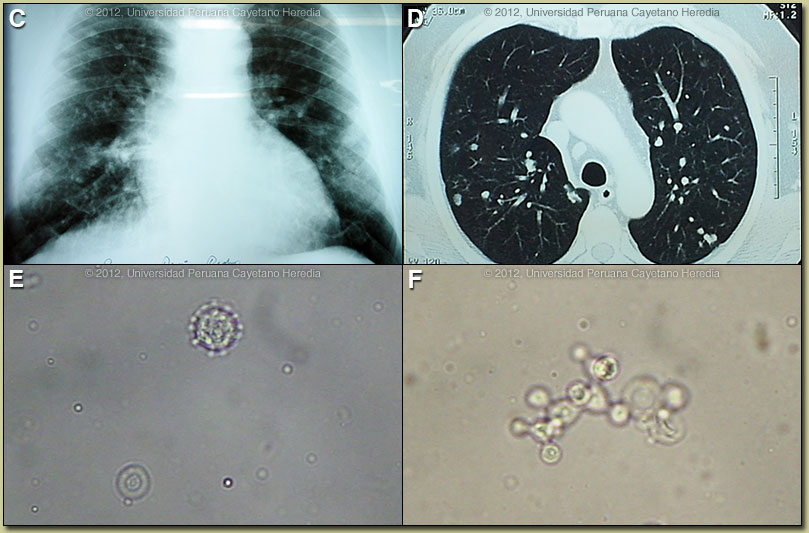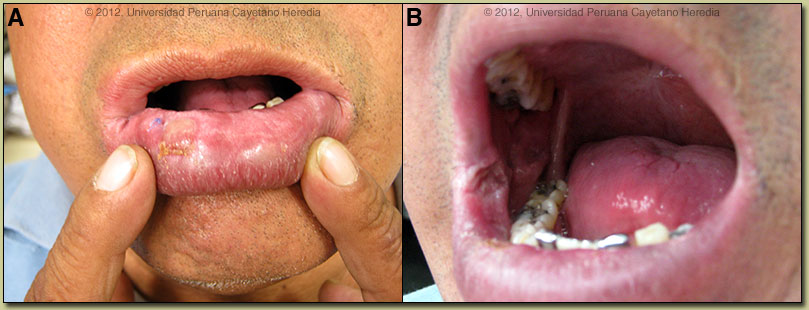2012 Case #7 |
 |
| Diagnosis:Paracoccidioides brasiliensis infection (chronic form) with mucosal involvement. |
 Discussion: Chest X-ray and CT are shown [Images C, D]. The diagnosis was made by simple KOH preparation of a mucosal scraping, which showed typical spherical cells 10-40 microns in diameter with a thick birefrigent cell wall [Image E]. Image F shows a budding yeast surrounded by several peripheral buds with typical narrow necks. When completely surrounded by such buds a so-called “pilot-wheel” pattern occurs. Direct scrapings will be positive in up to 90% of cases of paracoccidioidomycosis with oral lesions. Sputum AFB stain was negative. Biopsies are not necessary in characteristic clinical cases with positive scrapings. Discussion: Chest X-ray and CT are shown [Images C, D]. The diagnosis was made by simple KOH preparation of a mucosal scraping, which showed typical spherical cells 10-40 microns in diameter with a thick birefrigent cell wall [Image E]. Image F shows a budding yeast surrounded by several peripheral buds with typical narrow necks. When completely surrounded by such buds a so-called “pilot-wheel” pattern occurs. Direct scrapings will be positive in up to 90% of cases of paracoccidioidomycosis with oral lesions. Sputum AFB stain was negative. Biopsies are not necessary in characteristic clinical cases with positive scrapings.
The major differential diagnosis in Perú of oro-pharyngeal lesions in non-HIV infected patients would be mucosal leishmaniasis, paracoccidioidomycosis, carcinoma, or lymphoma. In Perú, leishmaniasis with destructive but painless lesions would be by far the most common. In general, oral lesions of paracoccidioidomycosis are painful, are frequently friable and bleed on contact, and gingival and buccal mucosa are frequently involved. The differential diagnosis for the lung disease includes: TB, histoplasmosis, lymphoma, cancer and cryptococcosis. This patient demonstrates the most typical radiographic pattern of paracoccidioidomycosis with bilateral mixed infiltrates (alveolar, interstitial, and nodular), mainly located in the middle and lower lobes. Interstitial lesions may have a miliary, nodular or fibronodular patterns. Other patterns observed in these patients are hilar and mediastinal lymph node enlargement, cavities, and calcified lesions. Extrapulmonary disease is found in over 70% of cases and may involve skin, mucous membranes, lymph nodes, adrenals, abdominal organs and CNS (in 10%). Bacterial superinfection of ulcerative oral lesions when they occur is more common than with oral ulcers due to mucocutaneous leishmaniasis. Paracoccidioidomycosis is most often an indolent and relapsing disease causing chronic pulmonary and mucosal manifestations. The chronic form (adult type) of the disease is believed to represent reactivation of latent infection initially acquired via inhalation. The chronic forms represent approximately 95% of all cases in the experience at our institute (120 patients, up to 2010), and approximately 85% in the Brazilian series [Rev Soc Bras Med Trop. 2003 Jul-Aug;36(4):455-9]. See examples of this in previous Gorgas Cases 2005-12, 2009-06, and 2004-05]. We have also previously shown a case of the chronic progressive form of the disease [Gorgas Case 2003-07] and the relatively uncommon “juvenile” acute progressive and disseminated form of the disease, which usually (but not always) affects adolescents and young adults [Gorgas Case 2010-07]. TB coexists in up to 10% of patients with paracoccidioidomycosis. Cavitation and pleural effusion are less commonly seen than in TB. Paracoccidioidomycosis, also known as South American blastomycosis, is found in humid forested or lush green areas of the Americas from Southern Mexico south to Uruguay and Argentina. It appears to be most common in Brazil. The exact habitat of the organism is unclear but transmission is described as being entirely by airborne inhalation. However, we have observed cases with only oral lesions apparently associated with the use of tree leaves contaminated with fungal spores as toothpicks. Primary pulmonary infection may be asymptomatic and self-limited, but even with treatment, will produce at least moderate pulmonary fibrosis. Rural adult male agricultural workers between 30-60 years of age are most affected by the infection. Travelers spending less than 6 months in an endemic area are unlikely to acquire paracoccidioidomycosis. Sulfonamides, ketoconazole, itraconazole, and amphotericin B are all effective therapies. For typical cases, itraconazole 100-200 mg/day for 6-9 months is regarded as the treatment of choice when it is available and affordable. Relapses are common with less than 6 months therapy and expert opinion is now that 1 year is not necessary. In the developing-world setting, ketoconazole is likely equally effective and is usually less than half the cost. However, 12 months of therapy with ketoconazole is generally recommended. Our patient was treated with amphotericin b (0.6 mg/kg/d) for one week, and then was switched to TMP/SMX 1600/800 bid for economic reasons. The plan is to give at least 6 months but preferably 1 year of therapy.Acknowledgements: We thank Dr. Maria Cruz and Dr. Roy García from the Social Security Hospital in Cuzco. |
